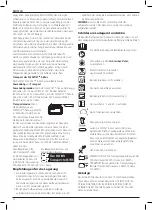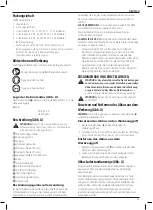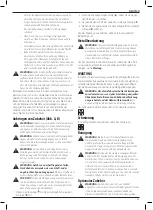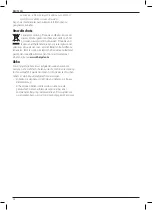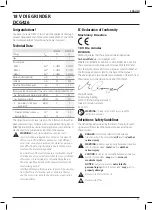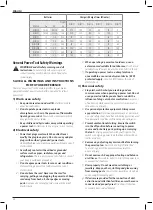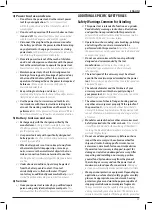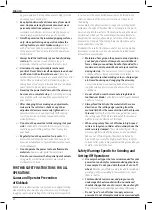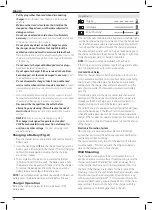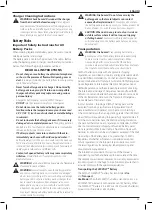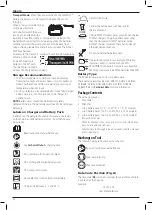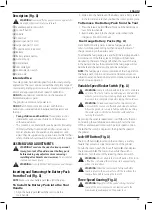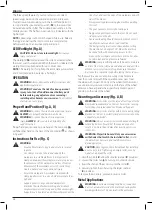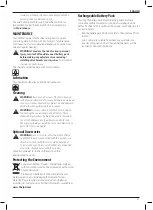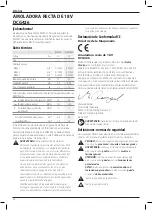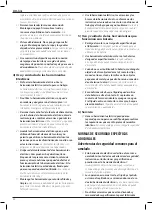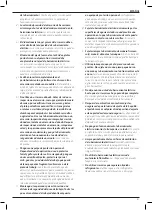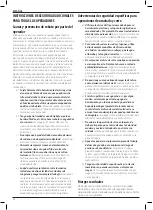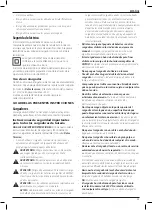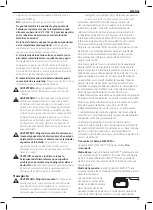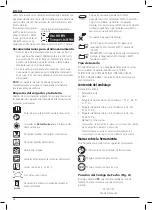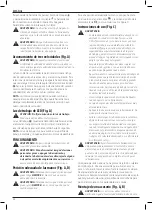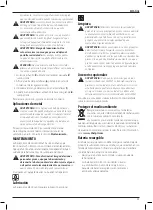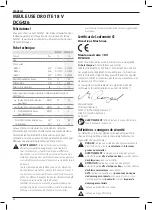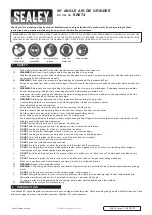
36
EngLIsh
The three-speed feature of your tool allows you to select
speed ranges based on the application and accessory used.
To select lowest speed setting, turn the tool off and permit it
to stop. Slide the speed selector switch
13
to the lowest rpm
indicated above the shifter. The middle speed setting is in the
middle position. The highest speed setting is indicated with the
highest rpm.
nOTE:
Speed ranges cannot be changed while in use. Release
the trigger and allow the tool to come to a complete stop
before switching to a new speed range selection.
LED Worklight (Fig. A)
CAUTION: Do not stare into worklight.
Serious eye
injury could result.
The worklight
12
located around the collet is activated when
the rocker switch is depressed. When the switch is released, the
worklight will stay illuminated for up to 20 seconds.
nOTE:
The worklight is for lighting the immediate work surface
and is not intended to be used as a flashlight.
OPERATION
WARNING:
Always observe the safety instructions and
applicable regulations.
WARNING: To reduce the risk of serious personal
injury, turn tool off and disconnect battery pack
before making any adjustments or removing/
installing attachments or accessories.
An accidental
start-up can cause injury.
Proper Hand Position (Fig. A, D)
WARNING:
To reduce the risk of serious personal injury,
ALWAYS
use proper hand position as shown.
WARNING:
To reduce the risk of serious personal
injury,
ALWAYS
hold securely in anticipation of a
sudden reaction.
Proper hand position requires one hand on the tool body
10
,
with the other hand on the neck of the die grinder
11
as shown
in Figure D.
Instructions for Use (Fig. C)
WARNING:
• Ensure all materials to be ground or cut are secured
in place.
• Use clamps or a vice to hold and support the
workpiece to a stable platform. It is important to
clamp and support the workpiece securely to prevent
the movement of the workpiece and loss of control.
Movement of the workpiece or loss of control may
create a hazard and cause personal injury.
• Secure the workpiece. A workpiece clamped with
clamping devices or in a vice is held more secure than
by hand.
• Support panels or any oversized workpiece to
minimize the risk of wheel pinching and kickback.
Large workpieces tend to sag under their own weight.
Supports must be placed under the workpiece near the
line of cut and near the edge of the workpiece on both
sides of the wheel.
• Always wear regular working gloves while operating
this tool.
• The gear case becomes very hot during use.
• Apply only a gentle pressure to the tool. Do not exert
side pressure on the disc.
• Avoid overloading. Should the tool become hot, let it
run a few minutes under no load condition.
• The best grinding results are achieved when setting
the machine at an angle of 90°. Move the machine
back and forth with moderate pressure. In this
manner, the workpiece will not become too hot, does
not discolour and no grooves are formed.
WARNING:
Grasp tool firmly with both hands to maintain
control of the tool at start up and during use and until the
wheel or accessory stops rotating. Make sure the wheel
has come to a complete stop be fore laying the tool down.
Put the work in a vise or clamp it securely. Use a face mask
over the nose and mouth if the operation raises dust. Treat
the wheel with respect. Do not jam the wheel into the work or
use unnecessary pressure. Grind only on the face of the wheel
unless you have a special wheel specifically make to permit
grinding on the side of the wheel.
Mounting an Accessory (Fig. A, B)
WARNING:
Accessories must be rated at least equal to the
maximum speed marked on the tool. Accessories running
faster than their rated speed can break and fly apart.
WARNING:
Accessories must be within the capacity rating
marked on the tool. Incorrectly sized accessories cannot be
adequately controlled.
WARNING:
Do not use accessories with a mandrel length
exceeding 40 mm. Ensure that the exposed mandrel
length is no more than 10 mm after inserting accessory
into collet.
WARNING: Projectile hazard. Only use accessories
with shanks that match the installed collet.
Smaller
shanks will not be secure and could become loose
during operation.
CAUTION:
Never tighten the collet without first installing
an accessory in it. Tightening an empty collet, even by
hand, can damage the collet.
1. Hold the spindle
3
using the smaller spanner
5
provided.
2. Loosen the collet nut
4
by turning it counterclockwise.
3. Insert the shank of the accessory into the collet
7
.
4. Securely tighten the collet using the larger spanner
6
provided.
To remove the accessory, proceed in reverse order.
Metal Applications
WARNING:
In extreme working conditions, conductive
dust can accumulate inside the machine housing when
working with metal. This can result in the protective
Summary of Contents for DCG426
Page 1: ...DCG426 Final page size A5 148mm x 210mm ...
Page 3: ...1 Fig B 5 6 10 mm max 8 9 Fig A 1 2 9 10 11 3 4 7 5 6 8 8 9 13 12 14 ...
Page 4: ...2 Fig C Fig D ...
Page 158: ...156 ...
Page 159: ...157 ...

